Awtar Singh Virdi is a contemporary artist from India who paints amazing portraits— but he does so in a very unique way.
If you only look at part of one of Awtar’s paintings, it will resemble nothing more than a circular abstract painting laid flat on the ground.
However, when a cylindrical mirror is placed on the painting in a specific location (notice the blank white circle in the painting above) everything changes.
As you can see, the mirror reflects the distorted image back to the viewer in a completely recognizable state. In this case, it’s a painting of the Crucifixion.
Awtar’s paintings are categorized under catoptric anamorphosis—catoptric means “mirror” and anamorphosis simply means “distorted until viewed a certain way.”
The only other type of anamorphosis is oblique anamorphosis, which you may have seen before in the work of chalk artists who create intricate sidewalk drawings that—from one direction only—appear completely realistic and three-dimensional.
What makes Awtar’s paintings even more fascinating is that he apparently paints them all freehand, without using a computer program, mathematical calculations, or any mechanical devices to map out the correct angles and curves.
I don’t know enough about his process to say for sure, but I’d bet that he simply paints on the flat surface while looking into the mirror itself—and over time he’s achieved incredible skill at doing so. (If you’ve ever tried to draw something while looking at your paper and pencil in a mirror, you know how tough that can be.)
As I mentioned on Sunday, the thing that I like most about this particular medium and process is that the end result combines so many different facets of art.
Awtar creates realistic portrait paintings. . . but in reality, they’re abstracts. And with the mirror in place, his work takes on a certain sculptural quality as well.
In other words, he’s essentially mixing sculpture, realism, and abstract painting in each piece, which to me is just incredible.
As far as I can tell, Awtar doesn’t have a website up at the moment (my apologies to those of you who would like to see more of his work) but I’ll be sure to post a link as soon as I know where to point it.
For more information on anamorphosis art, visit Wikipedia’s article on the subject.
This post may contain affiliate links.



